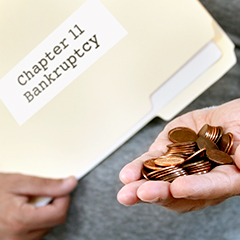Struggling Firms Get a Second Chance
September 30, 2016 | Accounting Standards, Business Plans, Debt & Financing, IRS Regulation
 Many business owners and executives feel like they’re admitting defeat when filing Chapter 11 bankruptcy, but it shouldn’t be that way.
Many business owners and executives feel like they’re admitting defeat when filing Chapter 11 bankruptcy, but it shouldn’t be that way.
Chapter 11 immediately freezes all financial claims against the company and stops lawsuits and collection activities.
The automatic stay provision of Section 362 in the bankruptcy code is the most important provision in achieving this goal. The automatic stay provides a time-out — a window of opportunity to fix problems, because in some cases, time is all that’s needed.The bankruptcy code exists to provide second chances. Chapter 11 covers business reorganizations, and allows struggling companies to right themselves so that they may once again be profitable engines of the nation’s economy.
Whenever a company, or an individual, files for bankruptcy, the automatic stay kicks in. Like a temporary injunction, the automatic stay prohibits any action by a creditor against the debtor or its property, and all debt collection actions against the company must temporarily cease.
Actions prohibited to a creditor under an automatic stay include foreclosure, repossession, and the filing of lawsuits. Also, while the stay is in place, the IRS is prohibited from issuing tax liens or seizing property.
There one major difference between the automatic stay in bankruptcy and a normal temporary injunction is that no hearing is needed for the automatic stay to take effect. It occurs as soon as a petition to file for bankruptcy is stamped at the court.
This allows a company to move forward without fear. The bankruptcy court has the power to punish creditors that knowingly violate a stay by filing a contempt charge against them. Harassing phone calls and should stop, but if they don’t, notifying the court of a creditor’s transgression generally ends the problem.
The debtor company is prohibited from paying most of its pre-petition debts while the automatic stay is in place. This provides a chance for the company to rebuild itself as a going concern.
However, limits on the duration of the stay for certain repeat filers are imposed by the bankruptcy law. These debtors must seek a stay from the court in order to have the protection of the automatic stay.
You might think that filing for bankruptcy to get an automatic stay sounds all well and good, but filing will surely dry up the pool of available credit for things such as operating expenses. Won’t bankruptcy tie the company’s hands and kill any hope of future success? This is generally not the case. Sometimes, a struggling company has an easier time obtaining credit once bankruptcy has been filed and the automatic stay is in place.
Credit availability tends to increase because of the prohibition against paying pre-existing debts. Before any payments can be made on any pre-pretition debts, all debts incurred after bankruptcy has been filed (post-petition debts) must be paid first. Credit is likely to be available as long as the company shows that it can operate profitably if it doesn’t have to immediately pay its pre-petition debts.
For some businesses, no amount of time can fix things, and the automatic stay is not a cure-all. But for a company that is fundamentally strong, with credit in hand, the automatic stay provides an important opportunity to talk to creditors and get back on track. Consult with Filler & Associates or your accountant about the best way to proceed. And keep in mind that corporations that successfully come out of bankruptcy almost always do so because of fruitful negotiations with creditors.
